|
Home Who Can Play Where is it Played The Gear The Official Rules The Picture Gallery The T-Shirt The Video Related Sites E-mail us at: underwaterfootball@ underwaterfootball.com |
|
This site is maintained by: Sean Ennis Contributed to by |
UNDERWATER FOOTBALL
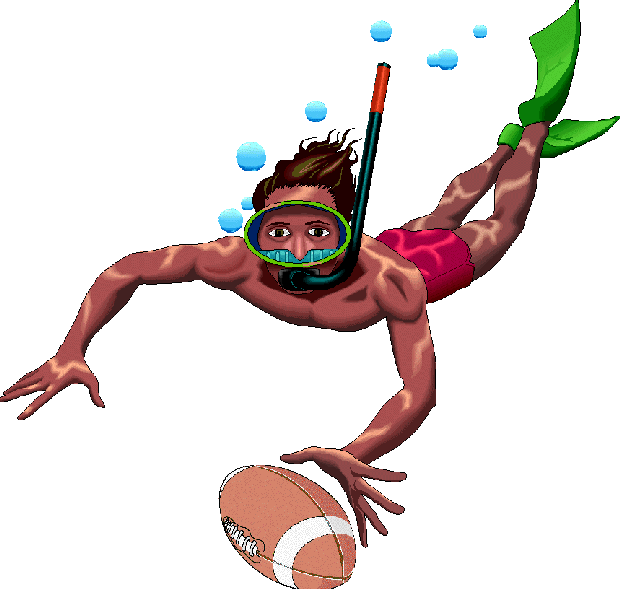
RULES AND REGULATIONS
TABLE OF CONTENTS
- DESCRIPTION
- PLAYING AREA AND EQUIPMENT
- TEAM FORMATION AND EQUIPMENT
- THE GAME
- PENALTIES AND FOULS
- OFFICIALS AND THEIR EQUIPMENT
- PROTESTS AND APPEAL
- SANCTIONING BODY
- DESCRIPTION
Underwater Football is a sport played within a swimming pool by two teams of not more than 13 players per team. Of these 13 players, only 5 shall be positioned in the play area. Each player wears the basic skin diving equipment, i.e. fins, face-mask, and snorkel. The object of the game is to carry a negatively buoyant ball underwater and deposit it within the opposing team's goal area. The ball carrier may be tackled or stripped of the ball. But a tackler must keep the ball in view and immediately release the ball carrier if the ball is dropped.Typically Underwater Football is played as a club-based activity, with teams chosen from players in attendance on a given evening. Rules spelled out herein are intended for tournament play, and may be modified as required to reflect club requirements, pool situations, and player skill level.
For further explanation of strategies and suggestions, consult The Manitoba Underwater Council Underwater Football Coaching Manual.
- PLAYING AREA AND EQUIPMENT
- PLAYING AREA
- The playing area shall be a swimming pool or part thereof. The dimensions shall be (xx) metres
wide, (xx) metres long, and with a depth of water between 3
metres and 5 metres. (All dimensions +/- 10%).
Ed.: These dimensions have not been officially set; however, a minimum width (goal side) of 10 metres and length of 15 metres would cover most playable pools. - The goal areas must be of a solid nature, i.e. the pool gutters or deck.
- The goal lines shall be marked on the side of the pool, both above and below the surface.
- A pool wall may be used as a sideline.
- The playing area shall be a swimming pool or part thereof. The dimensions shall be (xx) metres
wide, (xx) metres long, and with a depth of water between 3
metres and 5 metres. (All dimensions +/- 10%).
- GOAL AREAS
-
1. The goal lines shall be a minimum of 1 metre inside of the sideline, not exceeding (xx) metres (+/- 10%).
See Appendix One.
Ed.: This dimension has not been officially set; however, a maximum width of 3 metres on each side would cover most playable pools. - THE FOOTBALL
-
1. The prime considerations in the selection of a ball are that it be
soft sided and negatively
buoyant. Currently, two different balls are in use: an NFL
football filled with syrup, and a number 4 basketball filled with saltwater. Both balls have been
sanded to a smooth surface.
- PLAYING AREA
- TEAM FORMATION AND EQUIPMENT
- TEAM COMPOSITION
- A team shall consist of not more than 13 players.
- For any one match, a maximum of 13 team members must be nominated, only 5 of whom may be in the play area at any one time. The remaining players wait on the side of the pool to be used as substitutes.
- TEAM SUBSTITUTES
- Substitutions may be made at any natural break in play, i.e. when a goal is scored or at half time.
- A substitution may also be made in the event of an accident or injury, but only with the approval of the Chief Referee.
- Players may be substituted during the time play is stopped due to an infringement of the rules.
- TEAM EQUIPMENT AND IDENTIFICATION
- All team members shall wear proper swim suits.
- Wet suits and weight belts may not be worn.
- All team members shall wear coloured tape on their wrists and ankles. Each team shall display a different colour.
- PERSONAL EQUIPMENT
- Each player shall be equipped with a goggles or dive mask (which must be fitted with tempered glass), a snorkel and either a monofin or a pair of swim fins.
- Head or ear protection may be worn on the approval of the Chief Referee.
- Any other protective equipment must be approved by the Chief Referee.
- The wearing of watches, rings, and other jewellery shall not be permitted
- Players may not use equipment which may be deemed hazardous, i.e. masks or fins with sharp or pointed edges.
- Long fingernails shall not be allowed.
- The Chief Referee may outlaw the wearing of any equipment that they may consider hazardous.
- TEAM COMPOSITION
- THE GAME
- DURATION OF PLAY
- In tournaments, the match shall last 23 minutes, consisting of two 10 minute periods with a 3 minute break at half time, during which the teams shall change ends.
- A match is said to be "in play" during the period between the start and end of a play as signalled by the Chief Referee.
- In the case of a drawn match, an extra 10 minute period may be played to determine a winner.
- STARTING PLAY
- At the commencement of a match, half-time, or extra period, the starting position of the five players of each team, the football, and the two Water Referees is described below and illustrated in Appendix Four.
- Every player from each team shall be lined up at their own goal line and in contact with the pool wall in a manner that is visible to the officials. The football shall be at rest in the centre of the playing area. The Water Referee(s) shall be in the water at the sideline, adjacent to the position of the ball.
- When a match is due to commence, or re-commence after half-time, a 30 second warning shall be given by the Chief Referee to the players. At the end of this warning period, the signal to commence play will be given.
- Should play be stopped due to a rule infringement, it is re-started
by the Chief Referee using one of the following methods:
- The Face Off: to perform a face-off, a Water Referee shall position the football on the bottom of the pool in an area of his/ her own discretion. The team captains shall assign one of their players in the water to take position on the surface above the football. The Chief Referee shall signal the play to commence and the designated players may submerge to take possession of the football. The remaining players may not submerge until the football is touched.
- After an infringement of the rules causing a team to lose possession of the football, the Chief Referee may award possession to the opposing team. The players may recommence play upon signal from the Chief Referee. The players shall be positioned as shown in Appendix Five.
- RULES OF PLAY
- The object of the game is to move the football underwater and deposit it within the goal area without committing a foul as described in Section 5.
- You may move the ball by swimming with it and handing it off, or by passing it to another team member while submerged.
- The player in control of the football may be tackled, but the tackler must keep the ball in view and immediately release the player when they are no longer in control of the football. See section 4.3.4.
- A player is said to be "in control of the football" as long as the player is governing the motion or position of the ball. Examples are dribbling or juggling the football, and holding it against the body of another player.
- Blocking is allowed as described in section 4.7.
- Scoring is accomplished as described in section 4.5.
- The football may not be carried in a player's bathing suit or any other article of clothing. While the match is in play, the football must be carried underwater within the playing area.
- STOPPING PLAY
- TIME
The signal to stop continuous run-time play is given by the Chief Referee upon:- indication by the Timekeeper that the period has been completed.
- an infraction of the rules.
- player injury.
- SUBSTITUTIONS
- Substitutions may be allowed only during a stoppage of play.
- INJURIES
- A player removed from a game due to an injury may not participate in the rest of the game.
- A player removed from a game due to an injury may be replaced by another player on the team
- SCORING PROCEDURES
- A player must be within an arm's reach of the side of the pool to score.
- A player must be in control of the ball, see section 4.3.4.
- The ball must be placed on the side of the pool in the goal area in such a manner that the ball comes momentarily to rest on the pool deck with the scorers hand still grasping the ball. At this point a goal has been scored and whatever happens to the ball subsequent to this point is irrelevant.
- "Momentarily at rest" means that the overall movement of the ball is temporarily stopped for a fraction of a second. It shall be at the sole discretion of the Goal Judge as to whether the ball has been "at rest" long enough for a goal to be scored.
- If the ball wiggles when it is placed on the pool deck, this is not considered part of "overall movement" of the ball and this shall not affect the goal judges determination as to whether a goal is scored.
- If the football bounces or slides out of the scorer's hands immediately after it is placed in the goal area, then no goal shall be allowed. However, the Goal Judges discretion shall prevail in such cases.
- If the ball falls out of, is dropped, or is knocked out of a player's hand before coming to rest on
the pool deck then:
- If the ball falls back into the water, play carries on uninterrupted.
- If the ball comes to rest on the pool deck, in or out of the goal area, the defending team is given the ball at their wall. The attacking team must give "halfway" and move back of the centre of the pool. See Appendix 5.
- A player must score with one continuous forward motion of the ball. If the motion is stopped, the player must completely submerge before making another scoring attempt. The player must loose hold of the side of the pool, but may retain grasp on the ball provided that he/she submerges after his/her forward motion is stopped. Retaining hold on the ball without submerging shall result in a "Surface Carry" penalty and holding on to the side shall result in a "Hanging onto the Side" penalty.
- If the ball is in the air, having been dropped or knocked out of the attacking player's hand while attempting to score, no player may catch the ball in the air and attempt to score with it. Such an attempt will result in a "Surface Carry" penalty.
- The goal area is defined as the area bounded by the water side of the pool, the back of the pool deck and the inside of the goal lines running across the side. A goal shall be allowed provided any portion of the ball is placed in the goal area.
- A goal shall be considered as valid when the Goal Judge so signals. The Referee has ultimate authority to overrule the Goal Judges decision, but only in extraordinary circumstances.
- A player may reach across the out of bounds area of the pool deck to the side limits of the goal area and then score by placing the ball in the goal area, subject to the limitations noted in the above sections.
- A player may reach over top of a defender in order to score, subject to the limitations noted in the above sections.
- DISALLOWED GOALS
- A goal may be disallowed:
- if a penalty results during the attempt or during the play leading up to the attempt.
- if the football should fail to come to rest within the goal area and pass into the sideline area or back into the playing area.
- if the football is thrown from the playing area.
- if the player makes a second attempt to score without submerging.
- WALL BLOCKING
- The offensive player must:
- execute the block only within an arm's reach of the pool deck.
- lock their arm's at the elbow.
- not "pin" the defensive player.
- The defensive player:
- is entitled to remove the offensive players from the wall provided they are within arm's length of the pool deck.
- may not go over top of an offensive player's head or shoulders but may go over the offensive player's legs or torso.
- Any player not meeting the above requirements shall be assessed an "Interference" penalty.
- DURATION OF PLAY
- PENALTIES AND FOULS
- CAUTIONING
For minor or accidental infringements, or for any other reason thought necessary by the Referee, a team or player may be cautioned about any aspect of their play.
- ADVANTAGE RULE
If at any time during play the Referee decides that a rule infringement does not affect the advantage held by the team in possession of the ball, play may be allowed to continue as if the offence had not occurred. Or, at the discretion of the Referee, assessing a penalty for an infringement may by delayed until the advantage of the team in possession of the ball is lost.
- PENALTIES
- LOSS OF POSSESSION
The team awarded possession of the ball restarts play from either half way or their goal area depending on which is first, when moving from the point of infraction toward their goal area.
- MINOR PENALTY
A minor penalty consists of a player being removed from the game and staying within the penalty area for one minute and the loss of possession of the football where applicable.
- MAJOR PENALTY
A major penalty consists of a player being removed from the game and staying within the penalty area for two minutes and the loss of possession of the football where applicable.
- EJECTING
- The offending player shall be ejected immediately from the game.
- For purposes of tournament play, a player who has been ejected from a game shall be ejected from the tournament.
- Any player who has been ejected may not be replaced on the team by
another player.
- DURATION OF PLAYER FOUL PENALTIES
- The full time of a penalty must be served unless the team with the player advantage scores. At this time, the penalized player may reenter the water. Exception: "Rough Play" penalty.
- Should there be one player from each team serving penalties and a goal is scored before the penalties expire, the player from the scoring team shall remain to serve his/her penalty and the other player may return to the game. Exception: "Rough Play" penalty.
- Should there be more than one player from a team serving penalties, and a goal is scored before a penalty expires, the player with the least amount of time remaining in their penalty shall be allowed to return to the game. Exception: "Rough Play" penalty.
- EXPIRATION OF PENALTIES
The offending player must await a signal from the Timekeeper indicating expiry of the penalty before re-entering the water. Re-entry is to be a controlled, seated entry into the water. Under no circumstances may a player jump or dive into the water whilst a game is in play. The re-entry must be made adjacent to the penalty area. See Appendix Three.
- FOULS
- DELAY OF PLAY
Delay of play occurs when a team or a player delays the progress of the game. The Referee shall have discretion in determining "delay". A minor penalty is assessed, with the offending team's Captain designating the player who is to serve it. The player must be chosen from the players in the water at the time of the infringement.
- TOO MANY PLAYERS
If, at the commencement of play or during play itself, a team has too many players in the water, a penalty shall be called. A minor penalty is assessed with the offending team's Captain designating the player who is to serve it. The player must be chosen from the players in the water at time of the infringement.
- ILLEGAL SUBSTITUTION
This foul occurs when players are exchanged while the play is in progress. A minor penalty is assessed to the player who was originally in the water.
- SURFACE CARRY
- Is committed when two players surface while in possession of the football. No penalty is assessed; however, a face off shall take place between the two players surfacing the football. See Section 4.2.4.a.
- When a player in possession of the football breaks the surface of the water with any part of their body or equipment with the exception of their fins and feet to the ankles, a Surface Carry has occurred. A "Loss of Possession" penalty is assessed. In addition, when repeated Surface Carries occur, the Referee may call a "Delay of Play" penalty against the offending team or player.
- HANGING ON TO THE SIDE OR POOL APPARATUS
This foul occurs when a player hangs on to the side of the pool for the purpose of affecting the play (e.g. blocking or goal tending). A minor penalty is assessed.
Exceptions:- A player may hold on to the side for the purpose of resting or adjusting equipment, providing the player is well out of the goal area. The player must remain within the play area.
- Any player who is in possession of the football and is attempting to score may hold on to the side to aid the scoring effort. Should the effort be unsuccessful, the player must immediately release the side of the pool and submerge completely.
- TECHNICAL FOULS
A technical foul occurs when a team or player shows unsportsmanlike conduct toward an opposing player or players or toward any official. Such conduct may consist of verbal remarks or any other action or gesture deemed inappropriate by the Referee. A major penalty will be assessed. Continuation of the penalized behaviour shall result in the offending player being ejected from the game. The captain may then designate a replacement player, who must serve the penalty time.
- ROUGH PLAY
Rough play occurs when a player's performance, in the opinion of the Referee, may be considered hazardous to the other players. Examples of rough play are elbowing, kneeing, kicking, charging, strangle holds, or tackles above the shoulders. A major penalty is assessed. In addition, the entire major penalty must be served, regardless of any goals scored against the penalized team during this period.
Any player who incurs a second rough play penalty during a game shall be ejected from the game upon assessment of the second penalty. The penalty must be served by a player designated by the team Captain. The designated player must be one who was in the water at the time of the infringement.
- HOLDING
Holding occurs when a player, either on the surface or underwater, holds another player who does not have possession of the football. A minor penalty is assessed.
- INTERFERENCE
Interference occurs when a player, either on the surface or underwater, intentionally prevents another player not in possession of the football, from engaging in the play. However, a player is not obligated to move out of the way of another player. The following examples would constitute an interference penalty: pushing another player, or flailing (as opposed to swimming) of arms and legs to impede the motion of another player. A major penalty is assessed.
- FIGHTING
Fighting occurs when a player gives another player multiple blows, or displays persistent and excessive aggressive behaviour toward another player. The player does not need to retaliate. The offending player shall be ejected immediately from the game. In addition, a "Rough Play" penalty shall be assessed against the offending player's team. The penalty must be served by a player designated by the team Captain. The designated player must be one who was in the water at the time of the infringement.
- EQUIPMENT REMOVAL
Equipment removal occurs when a player causes another player's mask, snorkel, fins, or bathing suit to be removed or displaced. A minor penalty is assessed.
- SURFACE THROW
Any player who intentionally throws the football out of the water shall be deemed to have committed a surface throw. A minor penalty is assessed.
- REFEREE'S PRIVILEGE FOUL
A Referee has the privilege to assess a player foul against a team if the official can not identify the particular offending player. The player designated to serve the penalty by the team Captain shall be one who was in the water at the time of the infringement. The penalty enforced will be identical to that set out under the appropriate player foul listed above.
- ADVANTAGE RULE
- OFFICIALS AND THEIR EQUIPMENT
- NUMBER, TITLES AND QUALIFICATIONS
- The officials who shall control an Underwater Football game are: a Chief Referee, two Water Referees, and two Lines Persons.
- The Referees and Lines Persons shall be qualified officials, appointed by the provincial sanctioning body.
- Other officials have no authority and will execute their duties only through the Chief Referee.
- OFFICIALS' EQUIPMENT
- The Chief Referee shall be equipped with a means of creating an audible signal above and below the surface of the water.
- The Water Referees shall be equipped with a face mask, fitted with tempered glass, a snorkel and swim fins. The Water Referees may wear a wetsuit and weight belt or they must wear clearly distinguishable T-shirts and coloured gloves.
- The Lines Persons shall be equipped with a flag for signalling goals and a whistle for signalling infractions of the rules. The Lines Person shall wear a coloured T-shirt to distinguish him/her from the other players and the Coach.
- The Timekeeper shall be equipped with suitable timing facilities, sufficient to time both the match and the penalties.
- The Scorekeeper shall be equipped with suitable means of keeping a written record of the match, and a scoreboard which shall be visible from all parts of the pool.
- CHIEF REFEREE DUTIES
- The Chief Referee's duties are conducted from a position on the pool side where an uninterrupted view of the playing area can be obtained.
- The Chief Referee is responsible for the following:
- All aspects and overall conduct of the game.
- Inspecting all playing equipment prior to a match.
- Signalling the start and stoppage of play in accordance with the rules.
- Instructing the opposing teams of any special requirements of the match.
- Observing any rule infringement which might only be visible from above the water and awarding appropriate penalties to offenders.
- WATER REFEREES' DUTIES
- Each Water Referee shall conduct their duties from the water. Each shall be responsible for one
half of the pool; see Appendix Two. Jointly, the water
Referees are responsible for the following:
- Enforcing the rules at all times.
- Signalling the Chief Referee to stop play by raising a gloved hand should infringements occur.
- Informing the Chief Referee as to the nature of the infraction and the offending team and player.
- The placement of the football and assignment of players to conduct a face-off.
- Ensuring the football is in the correct position as required to start the match.
- Signalling the Chief Referee to stop the game by raising a gloved hand should an accident or injury occur, and assisting the injured party to the pool side.
- LINES PERSONS' DUTIES
- The Lines Person's jurisdiction shall be limited to his/ her own goal line. See
Appendix Three.
The Lines Person is responsible for the following:
- Signalling the scoring of a goal to the Chief Referee and score keeper by raising his/ her flag.
- Signalling the Chief Referee to stop the play should a rule infringement occur by blowing his/ her whistle. They shall signal stoppage in play when a Water Referee raises his/her gloved hand.
- Monitoring the substitutions.
- DUTIES OF OTHER OFFICIALS
- The duties of the Timekeeper/Scorekeeper may be performed by one or more persons. These officials shall assume the same position adjacent to the Chief Referee.
- These officials are responsible for the following:
- Timing of play and indicating the completion of each time period to the Chief Referee.
- Timing players sent from the water for penalties and indicating to the players when they may re-enter the water.
- Stopping the timing of the period at the request of the Chief Referee.
- Stoppage of timed penalties shall correspond with the stoppage of the period timing.
- Keeping a written record of goals scored, the player and team accredited with the goals.
- Keeping a written record of penalties, the players and their penalty time.
- Announcing the final score at the end of a match, once the details of the match have been verified by the Referees.
- PROTESTS AND APPEALS
Should a protest be made about the conduct of a match whilst it is still in play, the Chief Referee, with the assistance of the Water Referees, shall resolve the case. The Chief Referee's decision is final and under no circumstances will a post-game appeal be considered.
- SANCTIONING BODY
The sanctioning body for Underwater Football shall be The Manitoba Underwater Council Any requests for amendments to the rules shall be made in writing and forwarded to:
Manitoba Underwater Council
P.O. Box 711
Winnipeg, MB
R3C 2K3
- CAUTIONING
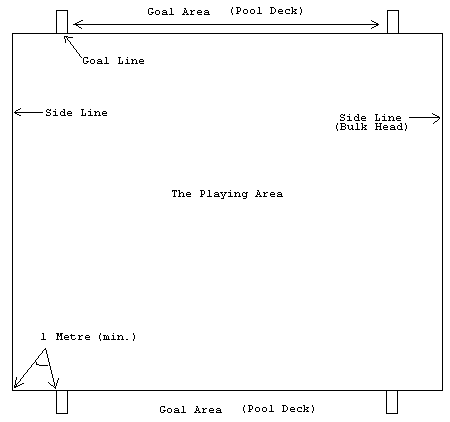
Appendix One
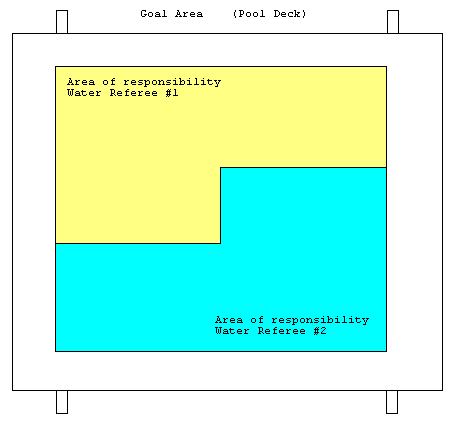
Appendix Two
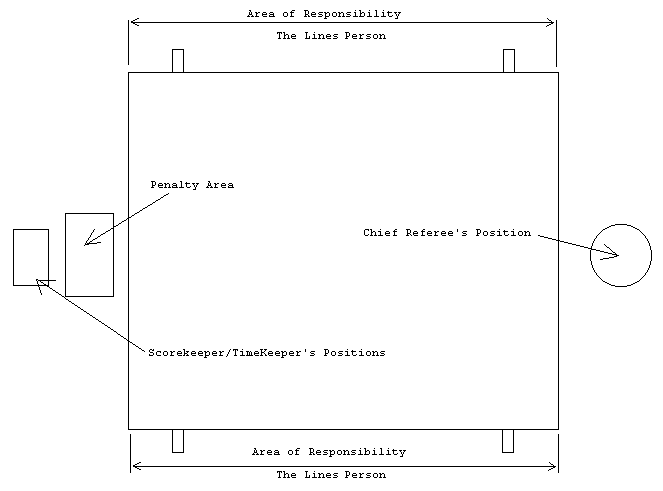
Appendix Three
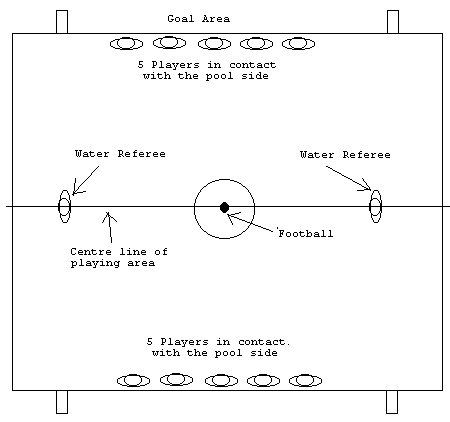
Appendix Four
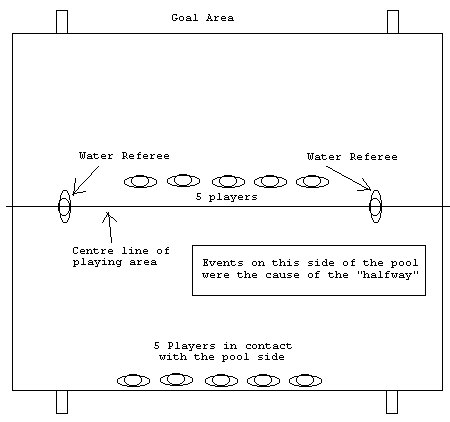
Appendix Five
 Home
Home